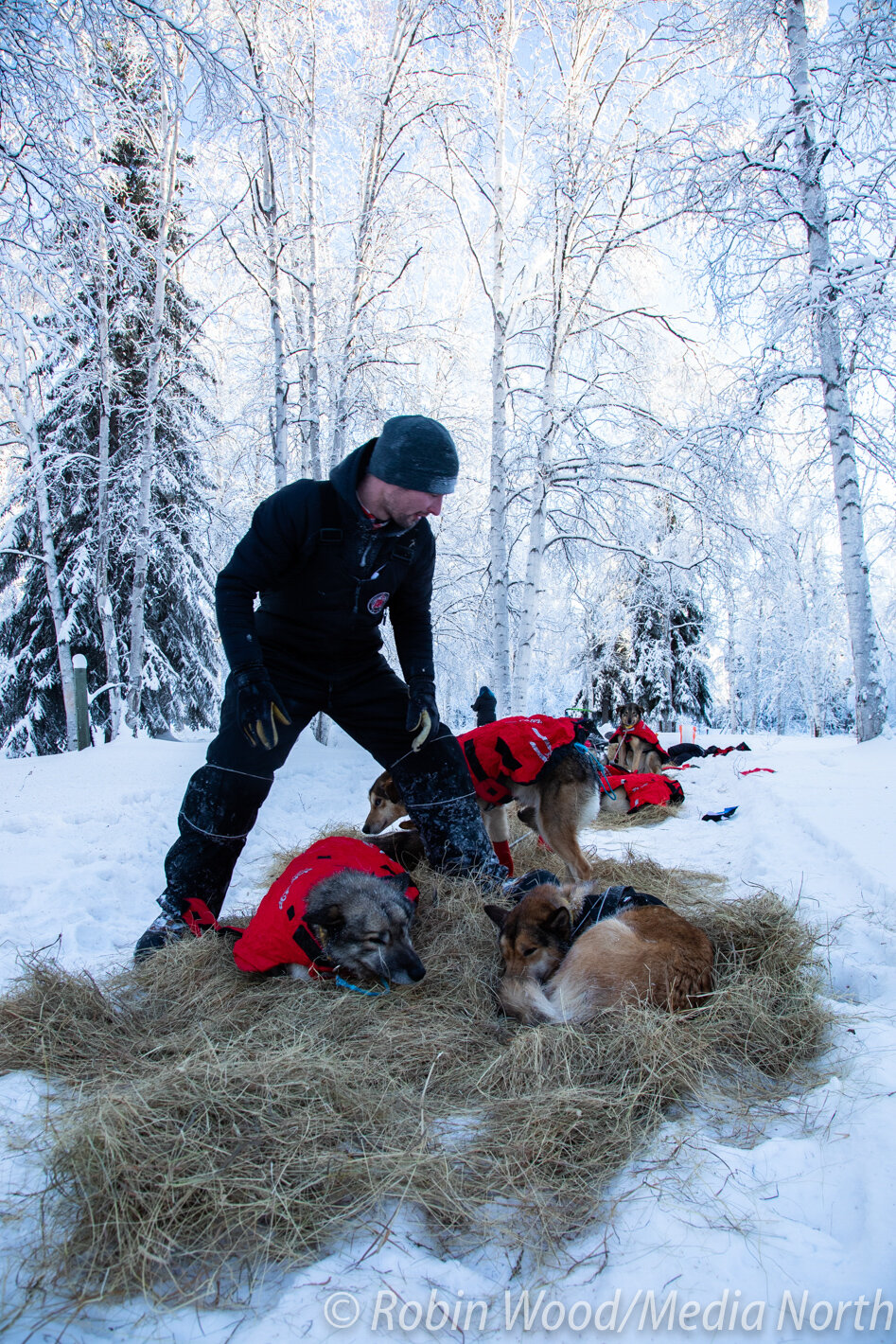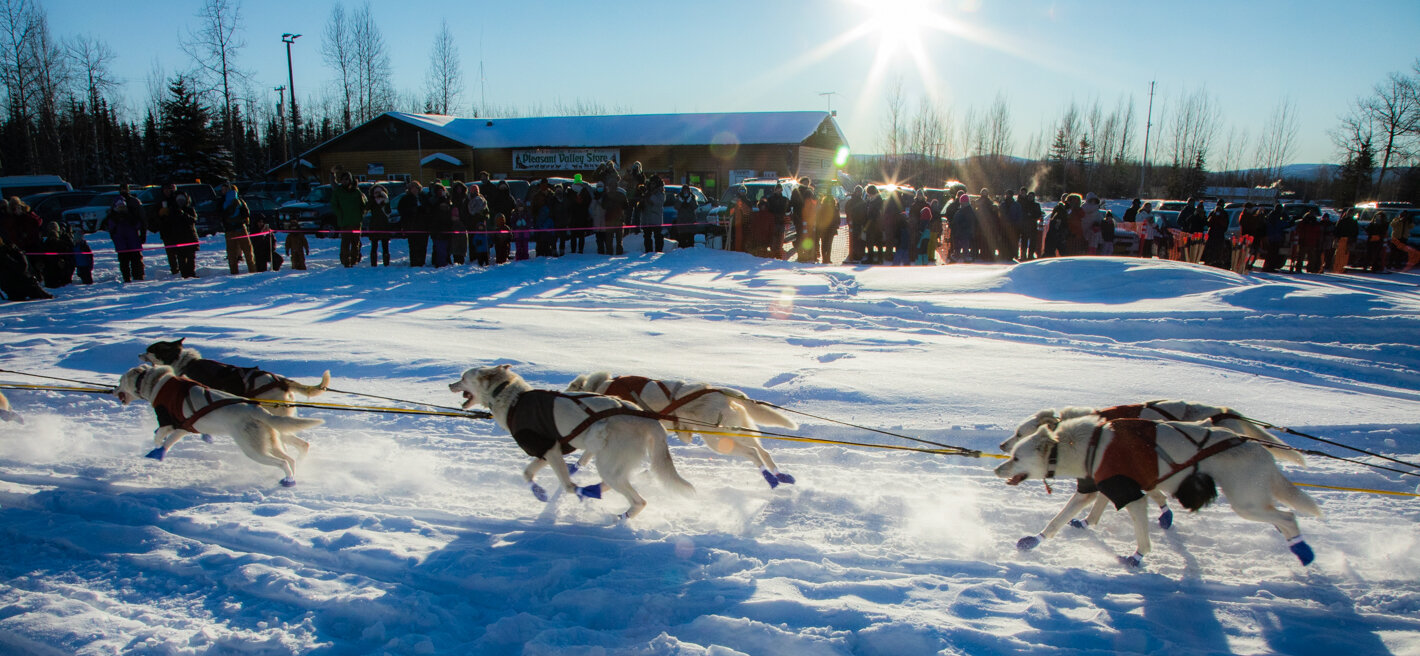Negative 40 and dark nearly all day. Take me back to a crisp, colorful fall day, when 40 above made for a chilly foray.
Tangle Lakes (3/3)
The previous two posts showcased the early and mid-trip highlights from the Tangle Lakes to Delta River float in Interior Alaska. Just before pulling off the river, the final panorama of the Eastern Alaska Range unfolds.
The tallest peak in the middle is Rainbow Mountain, all part of the Rainbow Ridge Complex, aptly named for the polychromatic colors. The Trans-Alaska Pipeline System, the lifeblood of Alaska’s economy, can be seen stretching across center frame.
Tangle Lakes (2/3)
Fall in Alaska is brief and spectacular. Vibrant colors may only stick around for a few days before receding into winter, especially at higher mountain elevations.
I have never seen grass turn such vibrant colors as I have along the Delta River in September 2020. Making the scene even more stunning was a dramatic cliff background with more wonderful fall foliage! While I do edit my images, I strive to make them look natural in terms of color and saturation. Colors often seem exceptionally vibrant on such a cloudy day.
Fall colors along the Delta River in Interior Alaska. Fall in Alaska is brief and spectacular!
Tangle Lakes (1/3)
Tangle Lakes is a spectacular Interior Alaska float in the heart of the Eastern Alaska Range, about 4 hours south of Fairbanks.
Start the trip paddling across the lakes (hopefully without headwind). Eventually the outlet forms the Delta River. Class V rapids are easy to portage before a section of fast and fun Class III boulder gardens. Finish with a leisurely but exciting and gorgeous Class I/II river.
Below is a panoramic overview shot of the lakes as it begins to form the Delta River. Opposite the lake are the Amphitheater Mountains, all awash in fall colors.
Alaska magazine feature
Seeing as February is almost over already, I better mention that I got an image in this month's edition of Alaska magazine, my first time being published in the periodical!
I took third place in the "Adventure" category of their photo contest. My award-winning image can also be seen near the bottom of my “Rivers and Mountains” page.
Makes me excited for more adventures!
I got my first photo featured in Alaska magazine for their annual photo contest in the February issue.
The image depicts a hiker dwarfed by Sukapak Mountain, one of. the first major Brooks Range mountains encounter while driving north on Alaska’s Dalton Highway.
In-between runs
Mushers do not just show up at a race, hop on a sled and take off. Especially any race associated with the Yukon Quest. It takes months of work to prepare, all while dog training must continue. Much of the hard work during a race occurs in the dog yards and checkpoints, start and finish lines. Driving to-and-from, bag drops, harnessing up teams, cleaning up after.
I rarely get to see mushers in action out on the trail, but the activity in dog yards and checkpoints is always exciting and lively.
Dogs always come first — bedding, booties, feeding, loading and unloading, vet checks, melting snow, snacks, jackets, more feeding. Toss in some sled repair and a musher snack, then hit the trail again with little to no sleep.
Volunteer veterinarian Margret Lenfest examines Yukon, a dog from the team of Two Rivers musher Lauro Eklund. Every dog in the race must be checked before the start and at Central Checkpoint, at a minimum. Lenfest is doing a residence specializing in canine sports medicine and rehabilitation at Cornell University, and took the opportunity to volunteer with the Quest. Feb. 12, 2021. Robin Wood for the News-Miner.
Deke Naaktgeboren, a Summit Quest 300 veteran from Fairbanks, puts jackets on his dogs after reaching Central Checkpoint. Naaktgeboren, who arrived in third place, wanted to give his dogs a little extra warmth after encountering overflow earlier in the race. Feb. 14, 2014. Robin Wood for the News-Miner.
Willow musher Adam Lindenmuth, a Summit Quest 300 rookie, gets settled at Circle City, the final checkpoint before the finish. Lindenmuth enjoyed the run along Birch Creek, as the flat ground is typical to his training grounds, but he had trouble earlier in the race on Rosebud Summit, terrain which his dogs are unfamiliar with. Feb. 15, 2021. Robin Wood for the News-Miner.
A handler from the team of veteran Fairbanks musher Tabitha Hughes pulls dogs out of their box prior to the start of the Summit Quest 300 on Saturday. Hughes runs a mix of huskies and traditional Inuit Greenland dogs and Malamutes. Feb. 13, 2021. Robin Wood for the News-Miner.
Joe Weber loads a dog from the team of Adam Lindenmuth into a dog box on Tuesday morning after the finish of the Summit Quest 300. Weber and Lindenmuth started mushing together when they lived in Colorado. Lindenmuth took fourth place and was the first rookie to finish. Feb. 16, 2021. Robin Wood for the News-Miner.
Rookie Bridgett Watkins unloads drop bags for the Summit Quest 300 on Thursday afternoon. The race starts 11 a.m. Saturday at Pleasant Valley Store, 23 MIle Chena Hot Springs Road. Feb. 11, 2021. Robin Wood for the News-Miner.
Fairbanks-based musher Ben Good tends to his team at the finish of the 2021 Summit Quest 300 on Tuesday morning. A former Quest 300 champion, Good finished this year’s race in fifth place. He took extra rest along the trail to give help build confidence in his young team. Feb. 16, 2021. Robin Wood for the News-Miner.
Summit Quest 300 winter Dan Kaduce of Chatanika gets help loading his sled onto his trailer Tuesday morning. Kaduce will now turn his attention to the march 7 start of the Iditarod. Feb. 16, 2021. Robin Wood for the News-Miner.
Alaskan's northern lights
I have a hard time coming up with catchy things to say about the northern lights. Sure, I could infuse this blog post with lots of adjectives and verbs about the brilliant dancing bands cutting through a vast sky speckled with stars that sparkle like diamonds.
No, all I’ll say is that pictures never do the northern lights justice. The following photos were taken along the Steese Highway northeast of Fairbanks, Alaska, on Feb. 15 and 16.
Northern lights fill the sky northeast of Fairbanks along the Steese highway, with car headlights visible in the far distance. Feb 16, 2021. Robin Wood/Media North
Northern lights fill the sky above a forest of scraggly black spruce, northeast of Fairbanks along the Steese highway. Feb 15, 2021. Robin Wood/Media North
Life on the trail
Mushers are the epitome of tough. Spending days on end camping in winter wilderness, faced with countless challenges — primary among them keeping the dog team safe and healthy.
The 1,000 Mile Yukon Quest Sled Dog Race was canceled this year due to Covid-19, but the shorter Summit Quest 300 was still held. Eighteen mushers started the race, 12 finished.
Frostbite and hypothermia are perhaps the most obvious environmental risks, with temperatures of 40 below or colder not uncommon throughout Interior Alaska. Staying dry can be difficult when teams encounter overflow, which occurs when flowing spring water can’t penetrate frozen ground, and instead percolates up in a slurry of ice and water. Ornery wildlife — moose, wolves and caribou — pose serious threats to teams. Snowmachines or cars striking a dog team happens about once per year throughout Alaska, and simple falls, whether due to challenging terrain or sleep deprivation, have resulted in serious concussions in recent years.
But when things go well, the results are a glorious fusion of synergy between the dogs and the musher in some of the prettiest country imaginable.
Fairbanks-based Deke Naaktgeboren mushes out of Circle City Checkpoint during the Summit Quest 300 in Interior Alaska. Feb. 15, 2021.
Fairbanks-based musher Deke Naaktgeboren travels along Birch Creek en route to a second-place finish during Interior Alaska’s the Summit Quest 300. Feb. 15, 2021.
Hugh Neff of Fairbanks mushes through a frozen black spruce bog during the Summit Quest 300. Neff is a two-time champion of the 1,000 Mile Yukon Quest Sled Dog Race, which was not held this year because of Covid-19. Feb. 15, 2021.
Adam Lindenmuth reachers the Circle City Checkpoint during the Summit Quest 300 in Interior Alaska. Lindenmuth mushes out of Willow, and was the top rookie in this year’s race. Feb. 15, 2021.
Summit Quest 300 champion Dan Kaduce cruises along Birch Creek in Interior Alaska. Birch Creek — notorious for being long, circuitous and cold — lived up to its reputation with temperatures around negative 50 this year. Feb. 15, 2021.
Eagle Summit Quest
Two daunting and potentially dangerous summits challenge mushers early in the Summit Quest 300. First, Rosebud Summit, around 80 miles in. Second, Eagle Summit, around 120 miles into the race.
Eagle Summit has road access, making and the wide-open spaces popular among race photographers. The vast expanse is also known for exciting changes in weather, and while low snow meant for a bumpy ride, mushers were greeted with a warm and calm bluebird beauty.
It takes the lead mushers about 24 hours reach Eagle Summit, and, often with considerable effort, they charge right up.
Fairbanks-based musher Deke Naaktgeborentgeboren crests Eagle Summit with a happy team during the Summit Quest 300. Feb. 14, 2021.
Hugh Neff, a two-time champion of the 1,000 Mile Yukon Quest International Sled Dog Race, mushes up and over Eagle Summit during the Summit Quest 300 across Interior Alaska. Feb.14, 2021.
Fairbanks musher Deke Naaktgeboren makes the final push up Eagle Summit, Interior Alaska, during the 2021 Summit Quest 300. Feb. 14, 2021.
The descent down Eagle Summit can easily challenge the best of mushers. Feb. 14, 2021.
Hitting the Quest trail
The 2021 Yukon Quest International Sled Dog race was canceled this year due to Covid-19.
But the 2021 Summit Quest 300, which incorporates the toughest challenges on the Alaskan side of the trail, is still happening! And my hometown newspaper, The Fairbanks Daily News-Miner, has asked my to cover the race for them, which will be my third time.
The race started Feb. 13 at Two Rivers, northeast of Fairbanks, Interior Alaska. I’m hitting the trial first thing today, with a winner expected around Tuesday. Follow my coverage at the News-Miner, and be on the lookout for fresh posts when I return!
Rookie Bridgett Watkins of Fairbanks was the final musher to hit the trail during the start of the Summit Quest 300 on Saturday. Although technically a rookie, Watkins has been mushing since the age of 5, and her dad and step-mom, Allen Moore and Aily Zirkle, are both elite long-distance mushers. Feb. 13, 2021. Robin Wood for the News-Miner.
Summit Quest 300 rookie Kai Leddy untangles her gangline prior the the start of the race on Saturday. This is Leddy’s second mid-distance sled dog race, and she hopes to run the Iditarod in 2022. Feb 13, 2021. Robin Wood for the News-Miner.
Pleasant Valley Store in Two Rivers hosted the start of the 2021 Summit Quest 300 due to bridge construction in Downtown Fairbanks. The full 1,000 Mile Yukon Quest was canceled due to Covid-19, but plenty of enthusiasm remained for a shorter race along parts of the trail. Feb. 13, 2021. Robin Wood for the News-Miner.































